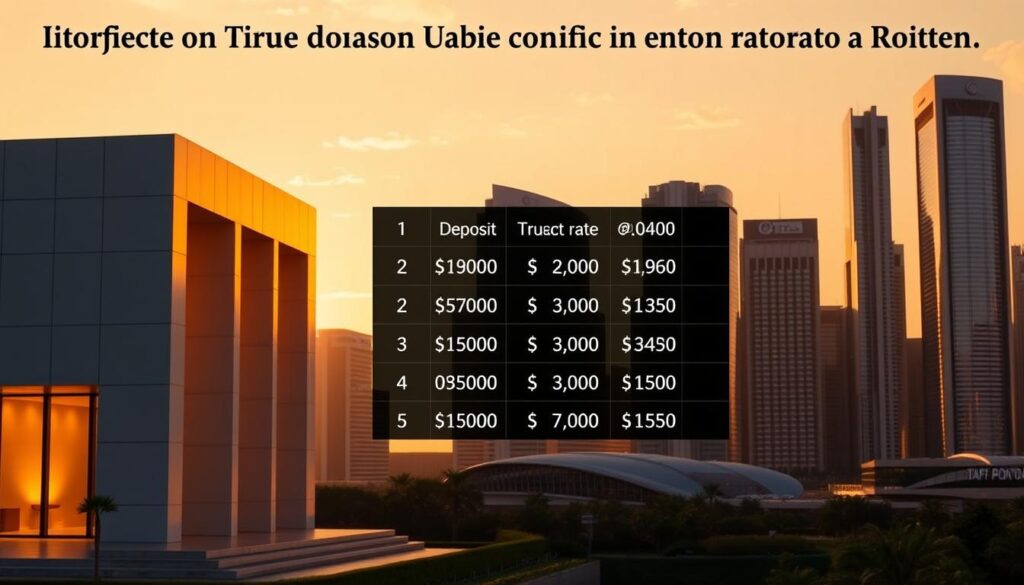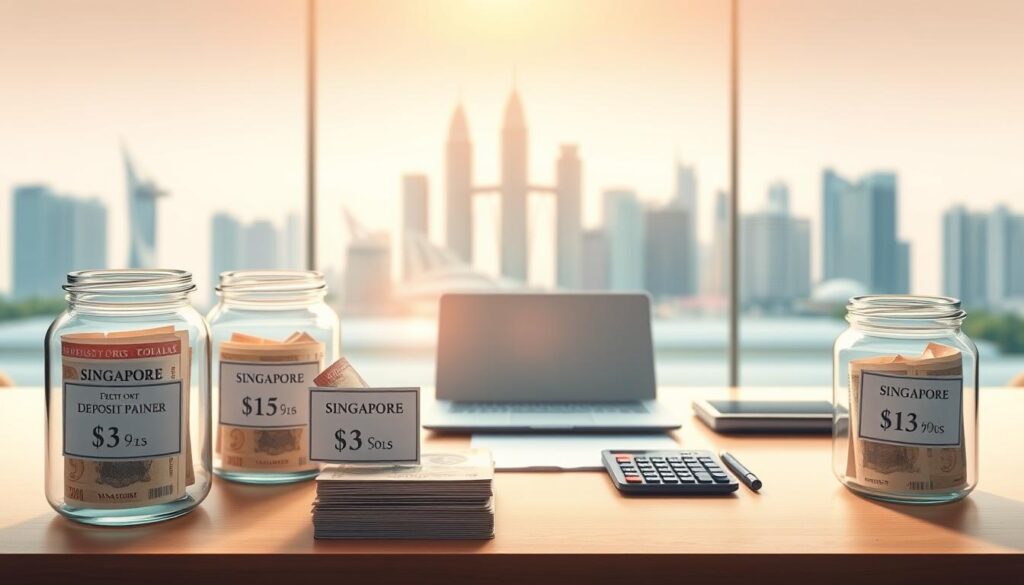Fixed deposits remain a popular choice for savers, even after rate adjustments since late 2023. These accounts offer a secure way to grow your savings with predictable returns. Currently, DBS/POSB leads the market with a rate of 1.60% p.a. for 9-12 month terms, making it a strong option for medium-term investments.
For those seeking flexibility, alternatives like cash management accounts provide higher returns without lock-in periods. For example, StashAway Simple™ Cash offers rates between 2.75% and 4.9% p.a. It’s a great option for those who want easy access to their funds while still earning competitive interest.
It’s important to stay updated with weekly rate changes to make informed decisions. Additionally, all fixed deposits in Singapore are insured by SDIC up to S$100,000, ensuring your savings are protected. Comparing these options with SSBs and T-bills can help you find the right fit for your financial goals.
Key Takeaways
- Fixed deposits offer secure and predictable returns.
- DBS/POSB provides a leading rate of 1.60% p.a. for 9-12 months.
- Cash management accounts like StashAway Simple™ offer higher flexibility.
- Weekly rate updates help you make timely decisions.
- SDIC insurance protects your savings up to S$100,000.
Introduction to Fixed Deposits in Singapore
For those seeking stability, fixed deposits offer a secure investment option. They allow you to lock in a lump sum at a predetermined interest rate for a fixed period. This ensures predictable returns, making them a popular choice for risk-averse investors.
What is a Fixed Deposit?
A fixed deposit is a financial product where you deposit a specific amount for a set tenure. In return, the bank pays you a guaranteed interest rate. For example, investing S$10,000 at 2.70% would earn you S$270 annually. This simplicity makes it an attractive option for many.
Why Choose Fixed Deposits in Singapore?
Here are some reasons to consider fixed deposits:
- Guaranteed Returns: Your money grows steadily without market risks.
- Capital Preservation: Your principal amount remains secure.
- Singapore Deposit Insurance: Your funds are protected up to S$100,000 under the SDIC scheme.
However, there are drawbacks. Early withdrawal penalties, like the S$50 fee at Hong Leong Finance, can reduce your earnings. Additionally, fixed deposits may not keep up with inflation, potentially eroding your returns over time.
Compared to high-yield savings accounts, which require active management, fixed deposits offer simplicity but less liquidity. Treasury bills (T-bills) also pose risks in the secondary market, making fixed deposits a safer alternative for many.
In 2024, the Monetary Authority of Singapore (MAS) increased SDIC coverage to S$100,000, further enhancing the security of your savings. This makes fixed deposits an even more appealing choice for those prioritizing safety and stability.
Top Fixed Deposit Rates in Singapore (August 2025)
Exploring the latest options for secure savings can help you make informed financial decisions. Banks are offering competitive interest rates and promotions, making it essential to compare options. Below, we break down the top choices for August 2025.

Bank of China: Competitive Rates for Short-Term Deposits
Bank of China stands out with its promotional fixed deposit rates. Mobile banking users can enjoy 1.65% for a 3-month term with a minimum of S$500. In contrast, counter rates are lower at 1.35%. This makes mobile deposits a better option for short-term savers.
DBS/POSB: Best Rates for 9- and 12-Month Tenures
DBS/POSB offers a unique tiered system. Deposits between S$1,000 and S$19,999 earn 1.60% for 9-12 months. However, amounts above S$20,000 receive only 0.05% more. This system favors smaller deposits, making it ideal for modest savers.
Hong Leong Finance: Online-Exclusive Promotions
Hong Leong Finance provides digital placement bonuses. For deposits of S$20,000 or more, you can earn 1.42% for 8-9 months. Their online-exclusive offers make it a convenient choice for tech-savvy investors.
Other Notable Banks: CIMB, OCBC, and UOB
Here’s a quick comparison of other banks:
| Bank | Term | Rate | Minimum Deposit |
|---|---|---|---|
| CIMB Preferred | 3 months | 1.65% | S$10,000 |
| UOB | 6 months | 1.50% | Fresh funds |
| SBI | 12 months | 1.40% | S$5,000 |
| Standard Chartered | 15 months | 1.00% | No minimum |
These options cater to different needs, whether you’re looking for short-term gains or flexibility. Always compare interest rates and terms to find the best fit for your financial goals.
Factors to Consider When Choosing a Fixed Deposit
Choosing the right fixed deposit account requires careful consideration of several factors. From the interest rate offered to the minimum deposit requirements, each detail plays a crucial role in maximizing your returns. Let’s explore the key aspects to keep in mind.

Interest Rates and Promotions
Banks often provide promotional rates that differ from their standard offerings. For example, Citibank offers a promotional rate of 1.40%, compared to its standard rate of 0.90%. Always compare these rates to ensure you’re getting the best deal.
Short-term deposits, like 3-6 months, may have lower rates compared to medium-term options of 9-12 months. Staying updated on these trends can help you make informed decisions.
Minimum Deposit Requirements
Minimum deposit requirements vary widely across banks. Bank of China allows deposits as low as S$500 for mobile banking customers, while HSBC Premier requires S$200,000. If you’re looking for a minimum deposit 10,000, options like CIMB Preferred are worth considering.
Some banks also require “fresh funds,” meaning the money must not already be in your account. Be sure to check these conditions before opening a new account.
Tenure Options and Flexibility
Tenure options range from 1 month to 12 months, each with its own benefits. Short-term deposits offer flexibility, while longer tenures typically provide higher returns. Here’s a quick comparison:
| Bank | Tenure | Interest Rate |
|---|---|---|
| Bank of China | 3 months | 1.65% |
| DBS/POSB | 12 months | 1.60% |
| Hong Leong Finance | 8-9 months | 1.42% |
Additionally, some banks offer auto-renewal policies, which can be convenient but may reset your rate. Early withdrawal penalties also vary, with Hong Leong Finance charging S$50 and UOB forfeiting interest. Always read the fine print to avoid surprises.
For more insights on fixed deposit rates, explore this comprehensive guide.
Best Deposit Rates Singapore: A Comprehensive Comparison
Understanding the differences between fixed deposit options can help you secure the best returns. With varying fixed deposit rates and promotional offers, it’s essential to compare banks to find the right fit for your savings goals.

Comparing Rates Across Banks
Banks offer a wide range of deposit interest rates, with some providing higher interest rates for specific tenures. For example, Bank of China offers 1.65% for a 3-month term, while HSBC provides 1.05% for the same period. Here’s a quick comparison of top banks:
| Bank | Term | Rate |
|---|---|---|
| Bank of China | 3 months | 1.65% |
| HSBC | 3 months | 1.05% |
| Citibank | 6 months | 1.40% |
Rate changes are frequent, with Bank of China updating its offers monthly. Staying informed ensures you don’t miss out on the best deals.
Promotional Rates vs. Standard Rates
Promotional rates often provide better returns than standard rates. For instance, Citibank’s promotional rate for a 6-month term is 1.40%, compared to its standard rate of 0.80%. These offers usually have expiration dates, such as HSBC’s promotion ending on 31 August.
Digital placement can also boost your returns. OCBC offers an additional 0.05% for online deposits, making it a convenient option for tech-savvy savers.
However, be aware of hidden costs. ICBC requires a minimum of S$20,000 for counter deposits, which may not suit everyone. Additionally, customer status can impact rates, with HSBC Premier offering better terms than personal accounts.
By comparing these factors, you can make an informed decision and maximize your savings.
Alternatives to Fixed Deposits in Singapore
Looking for ways to diversify your savings beyond traditional options? While fixed deposits offer stability, there are other secure and flexible alternatives worth considering. These options can provide higher interest or better liquidity, depending on your financial goals.

Singapore Savings Bonds (SSBs)
Singapore Savings Bonds (SSBs) are a low-risk investment option backed by the government. They offer a step-up interest structure, starting at 1.82% and increasing to 3.09% over time. With a minimum investment of just S$500, they are more accessible than many fixed deposit accounts.
SSBs also provide redemption flexibility, allowing you to withdraw your funds without penalties. This makes them ideal for those who need occasional access to their savings. For more details, check out this comprehensive guide.
Cash Management Accounts
Cash management accounts, like StashAway Simple™, offer instant liquidity and competitive returns. These accounts typically provide higher interest rates, ranging from 2.75% to 4.9%, without requiring a lock-in period.
However, they may carry slightly higher risks compared to fixed deposits. For example, Fullerton Fund offers a 1.80% return, but it’s essential to understand the underlying investments. These accounts are perfect for those who want easy access to their funds while still earning a decent return.
Foreign Currency Fixed Deposits
For those willing to take on additional risk, foreign currency fixed deposits can offer attractive returns. For instance, Bank of China provides a 4.00% rate for USD deposits, though the minimum investment is S$500,000.
Keep in mind that these deposits are not covered by SDIC insurance, and forex risks can impact your returns. In 2025, the USD/SGD exchange rate has shown volatility, which could affect your earnings. This option is best suited for experienced investors with a higher risk tolerance.
By exploring these alternatives, you can find the right balance between security, returns, and flexibility for your financial needs.
How to Maximize Your Returns with Fixed Deposits
Maximizing returns with fixed deposits requires strategic planning and awareness of key factors. By understanding how to structure your investments and avoid unnecessary penalties, you can make the most of your savings.
Building a Fixed Deposit Ladder
One effective strategy is creating a fixed deposit ladder. This involves splitting your deposit amount into multiple tranches with varying tenures. For example, you could divide S$30,000 into 3-month, 6-month, and 9-month deposits.
This approach offers both liquidity and rate optimization. As each tranche matures, you can reinvest it at potentially higher interest rates. A case study showed that laddering S$100,000 across four banks increased overall returns by 0.5% annually.
Understanding Early Withdrawal Penalties
Early withdrawal penalties can significantly impact your earnings. Penalties vary widely, from 0.10% at Hong Leong Finance to full interest forfeiture at some banks. Always calculate the cost before making an emergency withdrawal.
For large deposits, such as the minimum deposit 20,000, negotiation tactics can help secure better terms. Relationship banking benefits, like those offered by CIMB Preferred, can also enhance your returns.
Tools like Beansprout’s Telegram updates provide real-time alerts on rate changes, helping you stay informed and make timely decisions.
Bank-Specific Fixed Deposit Rates
When it comes to securing your savings, understanding bank-specific options can make a big difference. Each bank offers unique features and rates, so comparing them can help you find the right fit for your financial goals.
Bank of China: Mobile Banking vs. Counter Deposits
Bank of China provides competitive fixed deposit options, with distinct rates for mobile and counter deposits. Mobile banking users can enjoy a 1.65% interest rate for a 3-month term with a minimum of S$500. In contrast, counter deposits require S$20,000 and offer only 1.35%.
Setting up mobile banking is straightforward. You’ll need a smartphone, the bank’s app, and a valid account. This convenience makes it a popular choice for tech-savvy savers.
DBS/POSB: Tiered Rates Based on Deposit Amount
DBS/POSB uses a tiered system for its fixed deposit rates. Deposits below S$20,000 earn 1.60% for 9-12 months, while amounts above S$20,000 receive only 0.05% more. This inverse tiering benefits smaller savers, making it ideal for modest investments.
The rationale behind this structure is to encourage smaller deposits while still attracting larger sums. It’s a strategy that balances accessibility and profitability.
Hong Leong Finance: Online vs. Branch Rates
Hong Leong Finance offers digital placement bonuses for online deposits. For amounts of S$20,000 or more, you can earn an additional 0.02% interest rate for 8-9 months. This makes online deposits a more lucrative option compared to branch placements.
Existing customers can easily transition to digital onboarding, which simplifies the process. However, be mindful of account maintenance charges that may apply.
By understanding these bank-specific details, you can make informed decisions and maximize your savings potential.
Fixed Deposits vs. Other Low-Risk Investments
When comparing low-risk investment options, it’s essential to weigh the pros and cons of each. Fixed deposits are a popular choice, but alternatives like treasury bills and high-yield savings accounts also offer unique benefits. Understanding these differences can help you make smarter financial decisions.
Fixed Deposits vs. Treasury Bills (T-Bills)
Treasury bills (T-bills) are short-term government securities with a yield of 1.77% for a 6-month term. This is slightly higher than the 1.60% interest rate offered by fixed deposits. However, T-bills require participation in auctions, which can be less accessible for some investors.
One key advantage of T-bills is their government backing, which eliminates credit risk. Fixed deposits, on the other hand, are covered by deposit insurance up to S$100,000 under the SDIC scheme. Liquidity is another factor—T-bills can be sold in the secondary market, while fixed deposits may incur penalties for early withdrawal.
Fixed Deposits vs. High-Yield Savings Accounts
High-yield savings accounts, like the UOB One Account, offer up to 5.30% interest but come with specific criteria. For example, you may need to maintain a minimum balance or use linked credit cards. Fixed deposits provide fixed returns without such requirements, making them simpler for risk-averse investors.
Tax implications also differ. Interest from fixed deposits is fully taxable, while some savings accounts may offer tax advantages. Additionally, high-yield accounts often require active management, which may not suit everyone.
Here’s a quick comparison of key features:
- Liquidity: Savings accounts > T-bills > Fixed deposits
- Minimum Investment: T-bills (S$1,000) > Fixed deposits (varies) > Savings accounts (low or none)
- Credit Risk: Fixed deposits (low, with SDIC)
By understanding these differences, you can choose the option that aligns best with your financial goals and risk tolerance.
Tips for Choosing the Right Fixed Deposit Account
Selecting the ideal fixed deposit account involves more than just comparing numbers. It’s about aligning your financial goals with the right features and staying updated on market trends. Here’s how you can make a smart choice.
Aligning Tenure with Financial Goals
Your tenure options should match your financial objectives. For example, a 12-month term with DBS might suit a wedding fund, while a 6-month UOB account could be better for an emergency fund. Here’s a quick guide:
- Short-term goals: Choose 3-6 months for flexibility.
- Medium-term goals: Opt for 9-12 months for higher returns.
- Long-term goals: Consider combining fixed deposits with SSBs for a ladder strategy.
Monitoring Promotional Rates
Banks frequently update their promotional rates, so staying informed is key. Tools like Beansprout and BankBazaar offer real-time alerts on rate changes. For instance, CIMB rotates its promotions monthly, providing opportunities for higher returns.
Set calendar alerts for rate renewals to avoid missing out on better deals. Negotiation scripts can also help you secure preferred banking benefits, especially for larger deposits.
By understanding your needs and leveraging digital tools, you can maximize your fixed deposit interest and achieve your financial goals with confidence.
Understanding Deposit Insurance in Singapore
Protecting your savings is a top priority for many investors in Singapore. The Singapore Deposit Insurance Scheme (SDIC) ensures your funds are safe, even in uncertain times. This scheme covers up to S$100,000 per depositor per bank, providing a safety net for your hard-earned money.
What Does SDIC Cover?
The SDIC protects deposits in fixed deposit accounts, savings accounts, and current accounts. However, it excludes foreign currency deposits and structured products. This means your SGD deposits are fully insured, but other types may not be.
Here’s a quick breakdown of SDIC coverage:
| Account Type | Coverage |
|---|---|
| Fixed Deposit Accounts | Up to S$100,000 |
| Savings Accounts | Up to S$100,000 |
| Foreign Currency Deposits | Not Covered |
How Deposit Insurance Protects Your Funds
In the unlikely event of a bank failure, the SDIC ensures you receive your insured amount within 3-6 months. This quick turnaround minimizes financial stress and helps you recover your funds efficiently.
For joint accounts, the coverage is calculated per depositor. For example, a joint account with two holders is insured up to S$200,000. This ensures both parties are protected equally.
Historically, bank failures in Singapore are rare, but the SDIC provides an added layer of security. Compared to Malaysia’s PIDM, the SDIC offers similar coverage but with a streamlined claims process.
The SDIC is funded through premiums paid by member banks, ensuring no direct cost to depositors. This consumer protection framework is designed to maintain trust in Singapore’s financial system.
Conclusion: Making the Most of Fixed Deposits in Singapore
Securing your savings with fixed deposits offers both stability and predictable growth. With a current market ceiling of 1.60% for SGD accounts, it’s a reliable option for risk-averse investors. Emerging trends like digital-only promotions make it easier to access competitive rates.
Here’s a quick summary of top picks: for smaller amounts, consider Bank of China’s mobile banking options. For medium-sized deposits, DBS/POSB’s tiered system is ideal. Larger sums may benefit from Hong Leong Finance’s online-exclusive offers.
Always compare options using a rate checklist and prioritize safety by ensuring your funds are protected under the SDIC scheme. Diversifying across instruments like SSBs or cash management accounts can further enhance your returns.
Stay updated by joining rate alert communities and keeping an eye on seasonal promotions. With careful planning, you can maximize your savings and achieve your financial goals confidently.



